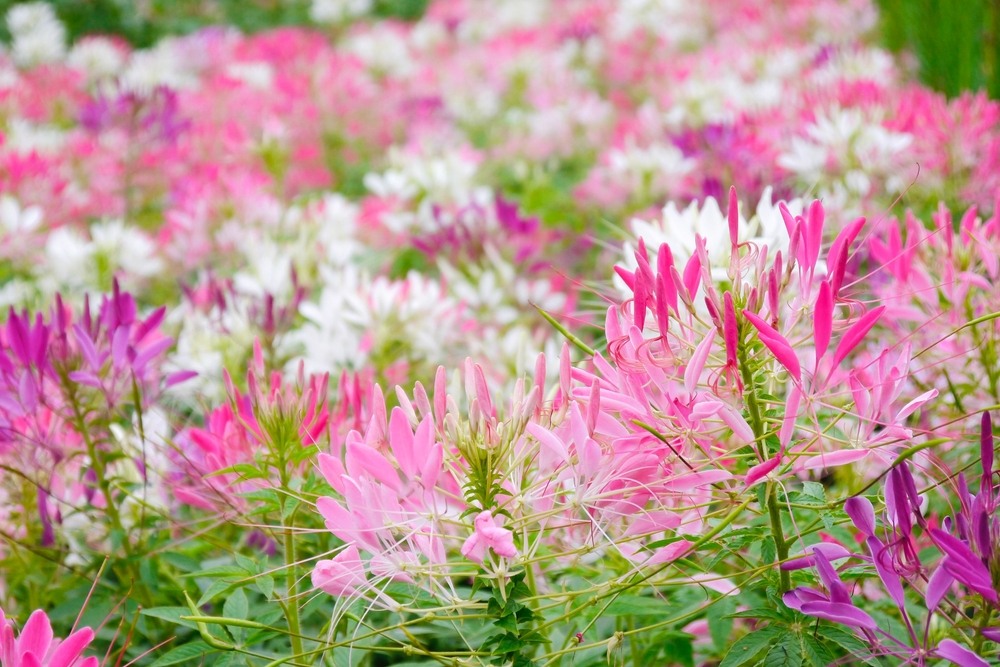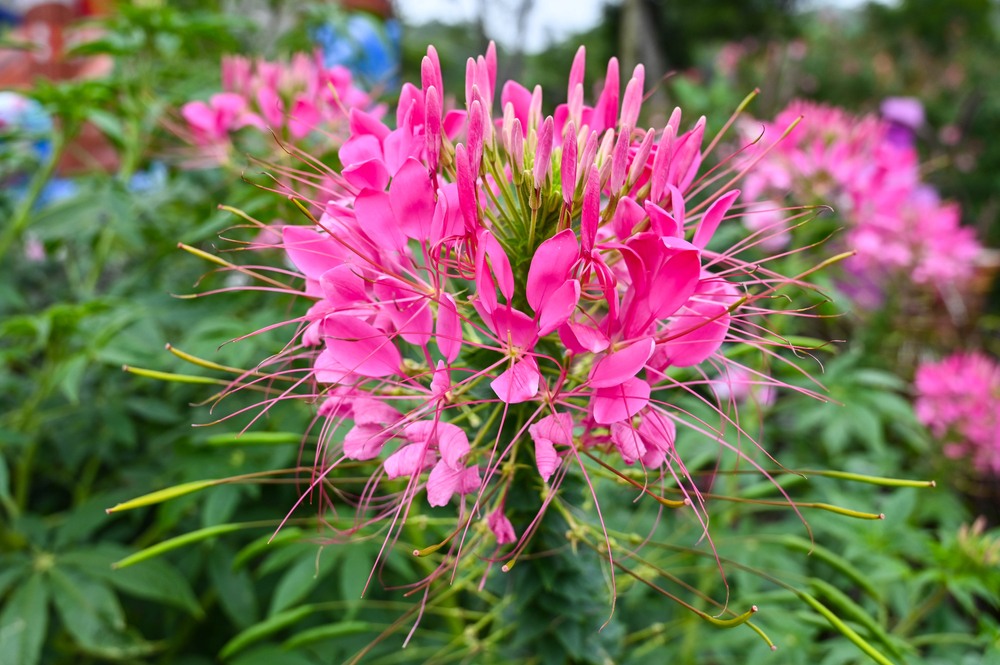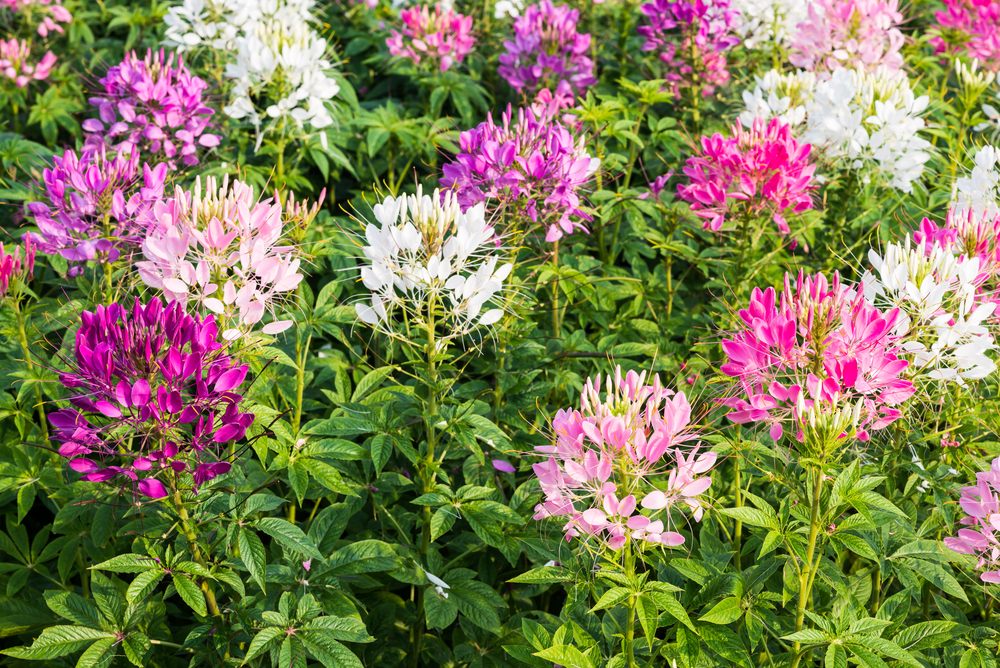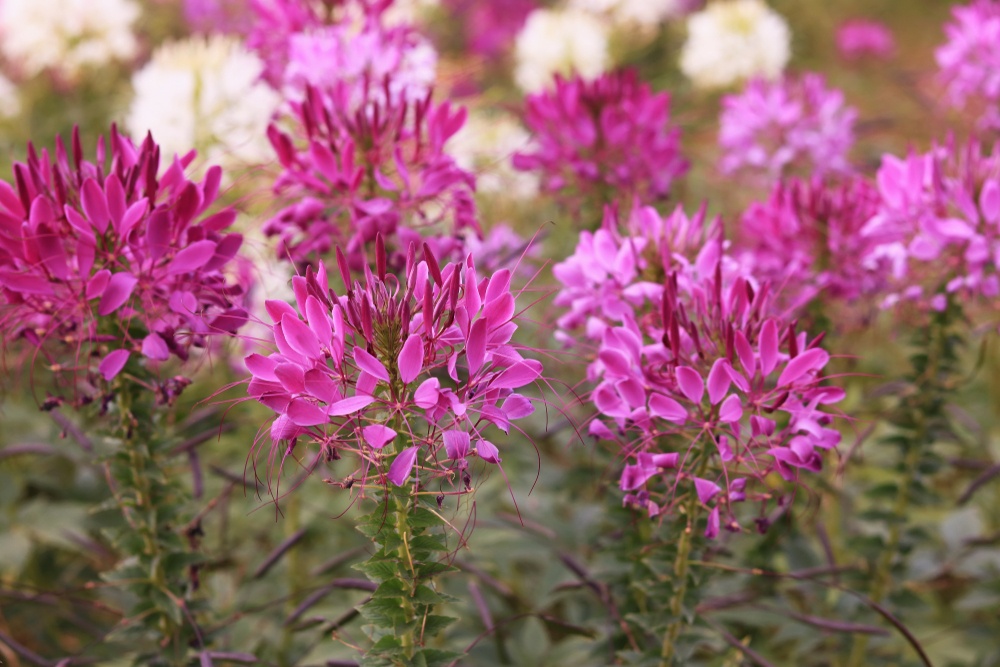
Cleome is a genus of plants that includes 170 species native to South America. Cleome hassleriana, often called a spider flower,is a tender perennial that can be grown as such in zones 10 and 11 but is commonly grown as an annual in flowerbeds across the U.S.
This showy flower is ideal for the middle or back of flower gardens to add color and movement to the bed. It produces airy flowers in shades of white, pink, and lavender that attract hummingbirds, bees, butterflies, and other flying insects to the garden.
It gets its common name of spider flower from its unusual blooms and seed pods that resemble spider’s legs.
| Botanical Name: | Cleome spp. |
| Common Name(s): | Spider Flower, Spider Legs, Grandfather’s Whiskers, Bee Plants |
| Plant Type: | Tender Perennial |
| Mature Size: | 1.5 to 5 feet |
| Sun Exposure: | Full or Partial Sun |
| Water Needs: | Medium to Low |
| Soil Type: | Average |
| Soil pH: | 6.0 to 7.0 |
| Bloom Time: | Summer to frost |
| Maintenance: | Low |
| Flower Color: | Pink, Rose, Lavender, White, Bicolor |
| Hardiness Zones: | 10, 11 |
| Toxicity: | Nontoxic |
Light
Cleome thrives in full to partial sun but will suffer if it receives too much shade. Cleome tends to grow tall and topple in rain or wind when grown in shaded areas. If you must grow them in a shady area of the yard, stake the plants with bamboo stakes or other plant supports.

Water
Seedlings need to be watered frequently to keep the soil moist so healthy roots can form. However, once the plants are established, they are drought tolerant. Water your cleome once a week to moisten the soil, but don’t worry if you are away on vacation. These vibrant flowers can generally fend for themselves.
Temperature & Humidity
Cleome is sensitive to cold temperatures and cannot tolerate even a light frost. Plant seedlings in the garden bed in the spring after all danger of frost has passed in your area.
Cleome can also be direct seeded into the flowerbed in the spring when the soil reaches a temperature between 70 and 75 degrees. Because Cleome does not bloom for 70 to 80 days after germinating, direct seeding isn’t recommended in cool climates with short growing seasons.
Seedlings can be started inside 6 to 8 weeks before the last expected frost in your area and transplanted to the garden when the weather warms, and all danger of frost has passed.
Soil
Cleome prefers well-drained soil with a pH between 6.0 to 7.0 but tolerates nearly any soil pH. It benefits from adding organic matter to the soil at planting time. Add well-rotted manure, compost, or peat moss to the existing soil to improve drainage and provide plenty of aeration for the roots. This typically adds enough nutrients for your cleome to thrive through the summer. too.

Fertilizer
Cleome does not require high amounts of fertilizer. Adding compost or well-rotted manure to the soil before planting typically provides the nutrients your cleome needs during the summer. You can, however, apply fertilizer for flowering plants with a hose-end sprayer every 10 to 14 days if you prefer.
Is Cleome Toxic?
According to the ASPCA, the Spider Flower (Cleome haserlana) is not toxic to dogs, cats, and horses. There is no evidence that cleome is toxic to humans. Planting them near play areas where small children and pets are active is safe.
Deadheading and Pruning
Flowers on the cleome plant begin at the bottom of a tall stem and bloom upwards. Old blooms are followed by long, slender seed pods that resemble spider’s legs. While it won’t harm your plants to deadhead them, many prefer to allow the seed pods to form as it adds dramatic interest to the flowerbed.
It should be noted, however, that removing the spent blooms regularly can extend the blooming season for your cleome. Removing the old blooms sends the message to the plant that it has not produced enough flowers to create seeds and reproduce. It responds by producing new flowers.
Likewise, cleome does not require pruning. However, pinching out new leaves on the growing tips of the plant when it is 6 to 8 inches tall will force the plant to send out branches and create a dense, compact plant.This may be especially beneficial for plants growing in shady areas as it can help prevent them from growing too tall.

Frequently Asked Questions:
Are spider flowers and spider plants the same plant?
Cleome (cleome spp.) is often called a spider flower due to the spidery appearance of the flowers and seed pods, while a spider plant (Chlorophytum comosum) gets its name from the tiny offsets it produces that look like little green spiders.
Spider flowers and spider plants are entirely different plants.
Do spider flowers come back each year?
Spider flowers (Cleome spp.) are tender perennials typically grown as annuals, but they can be grown as perennials in zones 10 and 11. They will come back on their own in zones 10 and 11. In addition, some cleomes self-seed readily, and although the parent plants die off in the fall, new plants will appear in the same general area in the spring.
Will deer eat cleome?
Spider flowers (cleome spp.) are both deer and rabbit-resistant.





